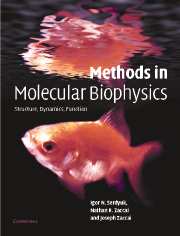Book contents
- Frontmatter
- Contents
- Foreword by D. M. Engelman
- Foreword by Pierre Joliot
- Preface
- Introduction: Molecular biophysics at the beginning of the twenty-first century: from ensemble measurements to single-molecule detection
- Part A Biological macromolecules and physical tools
- Part B Mass spectrometry
- Part C Thermodynamics
- Part D Hydrodynamics
- Chapter D1 Biological macromolecules as hydrodynamic particles
- Chapter D2 Fundamental theory
- Chapter D3 Macromolecular diffusion
- Chapter D4 Analytical ultracentrifugation
- Chapter D5 Electrophoresis
- Chapter D6 Electric birefringence
- Chapter D7 Flow birefringence
- Chapter D8 Fluorescence depolarisation
- Chapter D9 Viscosity
- Chapter D10 Dynamic light scattering
- Chapter D11 Fluorescence correlation spectroscopy
- Part E Optical spectroscopy
- Part F Optical microscopy
- Part G X-ray and neutron diffraction
- Part H Electron diffraction
- Part I Molecular dynamics
- Part J Nuclear magnetic resonance
- References
- Index of eminent scientists
- Subject Index
- References
Chapter D7 - Flow birefringence
from Part D - Hydrodynamics
Published online by Cambridge University Press: 05 November 2012
- Frontmatter
- Contents
- Foreword by D. M. Engelman
- Foreword by Pierre Joliot
- Preface
- Introduction: Molecular biophysics at the beginning of the twenty-first century: from ensemble measurements to single-molecule detection
- Part A Biological macromolecules and physical tools
- Part B Mass spectrometry
- Part C Thermodynamics
- Part D Hydrodynamics
- Chapter D1 Biological macromolecules as hydrodynamic particles
- Chapter D2 Fundamental theory
- Chapter D3 Macromolecular diffusion
- Chapter D4 Analytical ultracentrifugation
- Chapter D5 Electrophoresis
- Chapter D6 Electric birefringence
- Chapter D7 Flow birefringence
- Chapter D8 Fluorescence depolarisation
- Chapter D9 Viscosity
- Chapter D10 Dynamic light scattering
- Chapter D11 Fluorescence correlation spectroscopy
- Part E Optical spectroscopy
- Part F Optical microscopy
- Part G X-ray and neutron diffraction
- Part H Electron diffraction
- Part I Molecular dynamics
- Part J Nuclear magnetic resonance
- References
- Index of eminent scientists
- Subject Index
- References
Summary
Historical review
1870
J. Clerk Maxwell was the first to describe the phenomenon of double birefringence in flow (DBF), using Canada balsam as the liquid for study. DBF was produced by subjecting the Canada balsam to shear between two concentric cylinders, one of which rotated while the other was held fixed.
1932
P. Boeder presented the first theory of DBF. He formulated the main problem of the theory as finding the relation of the extinction angle and the magnitude of double refraction to the molecular dimensions of colloidal particles. Between 1938 and 1941, A. Peterlin and H. A. Stuart, and O. Snellman and Y. Bjornstahl proposed that this relation could be expressed as a function of a parameter that is equal to the ratio of the velocity gradient to the rotational diffusion coefficient. The crux of the problem was the determination of the rotational diffusion coefficient from experimental measurements of the extinction angle and the magnitude of double refraction.
1950s
H. A. Sheraga, J. T. Edsall and J. O. Gadd evaluated the extinction angle and birefringence numerically as a function of velocity gradient over a wide velocity gradient to rotational diffusion coefficients ratio range. This opened the way for the calculation of molecular dimensions of ellipsoidal particles from flow birefringence.
Late 1960s
G. B. Thurston proposed measuring birefringence in a hydrodynamic oscillating field. At the same time N. Davidson created a method for determining relaxation times from the decay of flow dichroism measurements.
Information
- Type
- Chapter
- Information
- Methods in Molecular BiophysicsStructure, Dynamics, Function, pp. 435 - 445Publisher: Cambridge University PressPrint publication year: 2007
